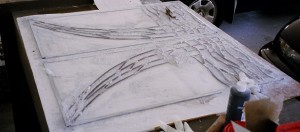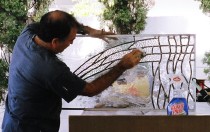Worship and Music Ministry Projects
Renovation of the Nave

New Altar—The altar was fabricated of Hawaiian ‘ohi‘a wood by Masako Schwalbenitz and donated by the Larry Nitz family. The original design was by Reese Fowler of Seattle. The altar was first used in worship on February 20, 2005 (Lent II). More details about the design, fabrication, and installation of the altar.
 Local woodworker Masako Schwalbenitz holds an MFA in painting with a minor in woodworking from Rochester Institute of Technology, NY. She started woodworking part-time after returning to Hawai‘i in 1997, and after various woodworking-related jobs and a year and a half apprenticeship on the Big Island, she established herself as a fully self-employed woodworker (and painter) in 2002. For the last four years, she has served as chairperson for Hawai‘i’s Woodshow, an annual juried woodworking exhibition organized by the Hawai‘i Forest Industry Association. Local woodworker Masako Schwalbenitz holds an MFA in painting with a minor in woodworking from Rochester Institute of Technology, NY. She started woodworking part-time after returning to Hawai‘i in 1997, and after various woodworking-related jobs and a year and a half apprenticeship on the Big Island, she established herself as a fully self-employed woodworker (and painter) in 2002. For the last four years, she has served as chairperson for Hawai‘i’s Woodshow, an annual juried woodworking exhibition organized by the Hawai‘i Forest Industry Association.
Top of Page
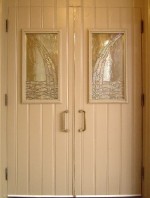 New Windows in the Nave Door—As the congregation contemplated renovations to the Nave, some members proposed adding translucent windows to the formidable doors. They hoped that this change would create a more welcoming feeling for newcomers since they would be able to see that activity was taking place inside the Nave. Members of LCH’s Mary Magdalene Society volunteered to underwrite the cost of installation, and the project was added to renovation plans. The glass panels themselves were given by the Castello family in honor of Randy’s parents, John (deceased Sept. 10, 2005) and Rosemary Castello. New Windows in the Nave Door—As the congregation contemplated renovations to the Nave, some members proposed adding translucent windows to the formidable doors. They hoped that this change would create a more welcoming feeling for newcomers since they would be able to see that activity was taking place inside the Nave. Members of LCH’s Mary Magdalene Society volunteered to underwrite the cost of installation, and the project was added to renovation plans. The glass panels themselves were given by the Castello family in honor of Randy’s parents, John (deceased Sept. 10, 2005) and Rosemary Castello.
 The windows were designed and fabricated by Randy Castello, one of the core members of our Liturgical Arts committee who has contributed several other class pieces to our worship. The design echoes the curved elements of the new altar. In the wooden altar, the curves are reminiscent of the tree of life, reaching up from earth to the heaven. In the glass panels, they resemble fountains of water pouring out of the heavens to be mingled with the waters of the earth. Ritual washing is a part of the worship experience in many cultures, and for Christians, this ritual washing takes place in Baptism. Thus, the fountains in the door panels remind all who gather for worship of the healing, restoring waters of their baptism. (Click on the detail on the left to view a larger version of the picture.) The windows were designed and fabricated by Randy Castello, one of the core members of our Liturgical Arts committee who has contributed several other class pieces to our worship. The design echoes the curved elements of the new altar. In the wooden altar, the curves are reminiscent of the tree of life, reaching up from earth to the heaven. In the glass panels, they resemble fountains of water pouring out of the heavens to be mingled with the waters of the earth. Ritual washing is a part of the worship experience in many cultures, and for Christians, this ritual washing takes place in Baptism. Thus, the fountains in the door panels remind all who gather for worship of the healing, restoring waters of their baptism. (Click on the detail on the left to view a larger version of the picture.)
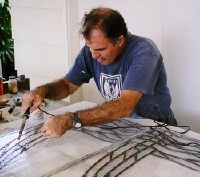 Clear glass was chosen for the panels so as not to compete with the colored windows inside, as well as to give those in the courtyards a glimpse of activity inside the Nave. The iridescent finish on the hammered glass used for he fountains makes them stand out. The background is made from a glass called Oceania, and the waves from Van Gough, a glass with ripples that reflect light like the ripples of the sea. Clear glass was chosen for the panels so as not to compete with the colored windows inside, as well as to give those in the courtyards a glimpse of activity inside the Nave. The iridescent finish on the hammered glass used for he fountains makes them stand out. The background is made from a glass called Oceania, and the waves from Van Gough, a glass with ripples that reflect light like the ripples of the sea.
The windows are leaded, rather than foiled. In this technique, pieces of glass are placed in H-shaped lead cames, and only the joints of those lead cames are soldered together (right). Glazing putty is then worked into the channels to seal the window, prevent the pieces of glass from rattling, and add overall strength. Finally, the windows are cleaned, first with whiting (a type of ground chalk) to remove the grease from soldering (below left), and then again with ordinary glass cleaner (below right).
Top of Page
 Repairs to the Alcove behind the Altar—When the Nave was renovated in the 1970s, extra space was added to the building on the Poki Street side where the altar now stands. It was designed with a free-standing back wall connected to the building with side walls and a roof of glass windows. From the beginning, the skylight leaked and water leached down through the concrete, emerging as blotchy spots on the wall that eventually blistered and peeled. The only ones happy with this situation were the cockroaches! Repairs to the Alcove behind the Altar—When the Nave was renovated in the 1970s, extra space was added to the building on the Poki Street side where the altar now stands. It was designed with a free-standing back wall connected to the building with side walls and a roof of glass windows. From the beginning, the skylight leaked and water leached down through the concrete, emerging as blotchy spots on the wall that eventually blistered and peeled. The only ones happy with this situation were the cockroaches!
Over the years, the wooden window frames became rotten, termites aggravated the problem, and the free-standing wall settled slightly, opening additional cracks for the rain. The picture to the right shows some of this damage. (To get a better look at the damage, click on the picture to view a bigger image.)
The repairs began in early May with the construction of a plywood wall so that the work could be hidden and the Nave could be both protected and used for worship during the renovations (below, left). New side windows with vinyl frames were installed and the skylight was replaced with a new roof. The back wall was also sealed with a copper hood to prevent water from percolating down. The final stages of the project included surface repairs, sanding, and painting. As part of this job, the small canopy that had been installed over the pulpit (which no longer exists) was removed (below, center). The final electrical and finishing work was then completed (below, right).
Top of Page
Computerized Pre-set System for the Organ
The main von Beckerath pipe organ is a mechanical action instrument that involves no electronics in the basic sounding mechanism. This mechanism is in excellent condition and has a life expectancy of 200 years. The stop action (the part that selects which pipes will produce sound), however, was 29 years old and becoming quite unreliable. Like a TV set from 30 years ago, things did not work well and parts were obsolete, so it could not be repaired. We were experiencing problems such as the stops not coming out when the piston was pushed or other stops being permanently set on certain pistons and incapable of being changed. We were seriously at risk for having the entire stop system fail so that the organ would have been unplayable.
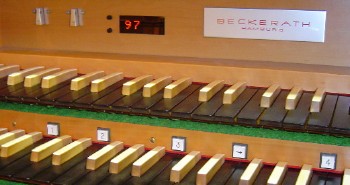 In January of 2004, Richard Houghten installed a solid-state circuitry system which upgraded the organ’s memory. The old system had six general pistons (like the push buttons on your car radio) to recall six different combinations of stops or tone colors. The organist could use these six buttons to quickly change stops for different hymn verses instead of having to pull the stops individually by hand. Our new system now has 12 general pistons, (an increase of six), but the biggest difference is that there are now 99 levels of electronic memory, totalling 1180 different combinations possible. In addition, a sequencer allows the organist to push a single button to move to the next piston in the sequence without having to hunt for the individual button. A digital display shows the level number in red and the piston number in green. This is like adding hundreds of rows of radio buttons to a car radio. In January of 2004, Richard Houghten installed a solid-state circuitry system which upgraded the organ’s memory. The old system had six general pistons (like the push buttons on your car radio) to recall six different combinations of stops or tone colors. The organist could use these six buttons to quickly change stops for different hymn verses instead of having to pull the stops individually by hand. Our new system now has 12 general pistons, (an increase of six), but the biggest difference is that there are now 99 levels of electronic memory, totalling 1180 different combinations possible. In addition, a sequencer allows the organist to push a single button to move to the next piston in the sequence without having to hunt for the individual button. A digital display shows the level number in red and the piston number in green. This is like adding hundreds of rows of radio buttons to a car radio.
As a result of this change, the organ does not sound any differently. The big change is in how it can be handled.The organist no longer has to frantically reach for stops by hand because she can use the sequencer button to effect a gradual crescendo. She is also able to store registrations for numerous choral pieces, saving a lot of time.
Top of Page
Freon-free Air Conditioning System
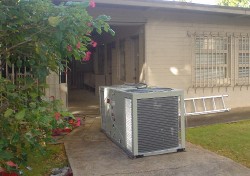 On August 24, 2004, a truck and crane appeared on the LCH campus with the long-awaited new air conditioning unit. Once it was in place and hooked up, workers cleaned out all the interior ducts, and the congregation could enjoy reliable air conditioning. On August 24, 2004, a truck and crane appeared on the LCH campus with the long-awaited new air conditioning unit. Once it was in place and hooked up, workers cleaned out all the interior ducts, and the congregation could enjoy reliable air conditioning.
 Copyright © 2005 Lutheran Church of Honolulu Copyright © 2005 Lutheran Church of Honolulu
Comments welcome at webmaster@lchwelcome.org |



